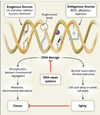Susceptibility of the aging lung to environmental injury
- PMID: 20941655
- PMCID: PMC4371868
- DOI: 10.1055/s-0030-1265895
Susceptibility of the aging lung to environmental injury
Abstract
With an ever-increasing number of elderly individuals in the world, a better understanding of the issues associated with aging and the environment is needed. The respiratory system is one of the primary interfaces between the body and the external environment. An expanding number of studies suggest that the aging pulmonary system (>65 years) is at increased risk for adverse health effects from environmental insult, such as by air pollutants, infection, and climate change. However, the mechanism(s) for increased susceptibility in this subpopulation are not well understood. In this review, we provide a limited but comprehensive overview of how the lung ages, examples of environmental exposures associated with injury to the aging lung, and potential mechanisms underlying the increased vulnerability of the aging lung to injury from environmental factors.
© Thieme Medical Publishers.
Figures


Similar articles
-
Lung injury after cigarette smoking is particle related.Int J Chron Obstruct Pulmon Dis. 2011;6:191-8. doi: 10.2147/COPD.S14911. Epub 2011 Mar 10. Int J Chron Obstruct Pulmon Dis. 2011. PMID: 21660296 Free PMC article.
-
Effect of PM2.5 environmental pollution on rat lung.Environ Sci Pollut Res Int. 2018 Dec;25(36):36136-36146. doi: 10.1007/s11356-018-3492-y. Epub 2018 Oct 24. Environ Sci Pollut Res Int. 2018. PMID: 30357727
-
Relationship between environmental exposures in children and adult lung disease: the case for outdoor exposures.Chron Respir Dis. 2010 Aug;7(3):173-86. doi: 10.1177/1479972309345929. Epub 2009 Oct 9. Chron Respir Dis. 2010. PMID: 19819910 Review.
-
Effects of long-term exposure to traffic-related air pollution on respiratory and cardiovascular mortality in the Netherlands: the NLCS-AIR study.Res Rep Health Eff Inst. 2009 Mar;(139):5-71; discussion 73-89. Res Rep Health Eff Inst. 2009. PMID: 19554969
-
Air Pollution modifies the association between successful and pathological aging throughout the frailty condition.Ageing Res Rev. 2015 Nov;24(Pt B):299-303. doi: 10.1016/j.arr.2015.09.004. Epub 2015 Oct 14. Ageing Res Rev. 2015. PMID: 26462883 Review.
Cited by
-
Aging, tobacco use and lung damages.Tunis Med. 2022 avril;100(4):295-302. Tunis Med. 2022. PMID: 36155900 Free PMC article.
-
Aging influence on pulmonary and systemic inflammation and neural metabolomics arising from pulmonary multi-walled carbon nanotube exposure in apolipoprotein E-deficient and C57BL/6 female mice.Inhal Toxicol. 2023 Mar-Apr;35(3-4):86-100. doi: 10.1080/08958378.2022.2026538. Epub 2022 Jan 17. Inhal Toxicol. 2023. PMID: 35037817 Free PMC article.
-
Ultrafine Particulate Matter Combined With Ozone Exacerbates Lung Injury in Mature Adult Rats With Cardiovascular Disease.Toxicol Sci. 2018 May 1;163(1):140-151. doi: 10.1093/toxsci/kfy018. Toxicol Sci. 2018. PMID: 29394414 Free PMC article.
-
Cell Proliferation and Apoptosis-Key Players in the Lung Aging Process.Int J Mol Sci. 2024 Jul 18;25(14):7867. doi: 10.3390/ijms25147867. Int J Mol Sci. 2024. PMID: 39063108 Free PMC article. Review.
-
Using Cell-Based Strategies to Break the Link between Bronchopulmonary Dysplasia and the Development of Chronic Lung Disease in Later Life.Pulm Med. 2013;2013:874161. doi: 10.1155/2013/874161. Epub 2013 Jan 14. Pulm Med. 2013. PMID: 23401768 Free PMC article.
References
-
- Sexton K. Sociodemographic aspects of human susceptibility to toxic chemicals:: Do class and race matter for realistic risk assessment? Environ. Toxicol. Pharmacol. 1997 Dec;4(3–4):261–269. - PubMed
-
- Crapo JD, Broaddus VC, Brody AR, Malindzak G, Samet J, Wright JR. American Thoracic Society. Workshop on lung disease and the environment: where do we go from here? Am J Respir Crit Care Med. 2003 Jul 15;168(2):250–254. Review. - PubMed
-
- Anderson HR, Atkinson RW, Bremner SA, Marston L. Particulate air pollution and hospital admissions for cardiorespiratory diseases: are the elderly at greater risk? Eur Respir J Suppl. 2003;21(suppl 40):39s–46s. - PubMed

